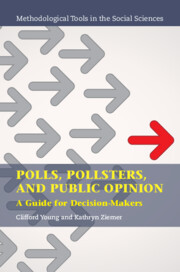Book contents
- Polls, Pollsters, and Public Opinion
- Methodological Tools in the Social Sciences
- Polls, Pollsters, and Public Opinion
- Copyright page
- Contents
- Figures
- Graphs
- Quadrants
- Tables
- Acknowledgments
- 1 The Three-Hatted Pollster
- Part I The Fundamentals of Public Opinion
- 2 What Is Public Opinion?
- 3 Attitude Formation at the Individual Level
- 4 When Public Opinion Is Stable and When It Is Not
- Part II The Pollster as Data Scientist
- Part III The Pollster as Fortune Teller
- Part IV The Pollster as Spin Doctor
- Index
3 - Attitude Formation at the Individual Level
from Part I - The Fundamentals of Public Opinion
Published online by Cambridge University Press: 01 November 2024
- Polls, Pollsters, and Public Opinion
- Methodological Tools in the Social Sciences
- Polls, Pollsters, and Public Opinion
- Copyright page
- Contents
- Figures
- Graphs
- Quadrants
- Tables
- Acknowledgments
- 1 The Three-Hatted Pollster
- Part I The Fundamentals of Public Opinion
- 2 What Is Public Opinion?
- 3 Attitude Formation at the Individual Level
- 4 When Public Opinion Is Stable and When It Is Not
- Part II The Pollster as Data Scientist
- Part III The Pollster as Fortune Teller
- Part IV The Pollster as Spin Doctor
- Index
Summary
This chapter examines how attitudes are formed. Attitude formation is explained as a function of prior beliefs and information. This process is viewed through two complementary lenses: the static process and the dynamic process. The static model thinks of attitudes as a combination of ratings and rankings. We term this the multi-attribute model – a commonly used approach in psychology and economics. The dynamic model concentrates on how humans process information, where things like words, symbols, and memory networks take on practical significance. Ultimately, both models have many applications for the practitioner.
Keywords
- Type
- Chapter
- Information
- Polls, Pollsters, and Public OpinionA Guide for Decision-Makers, pp. 25 - 37Publisher: Cambridge University PressPrint publication year: 2024

